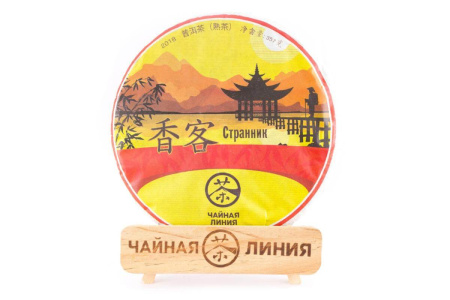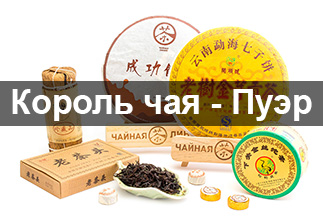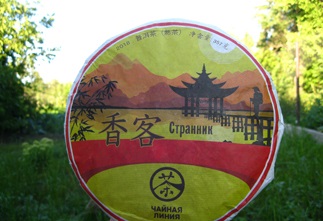-
10 Saturation
-
9 Aftertaste
-
9 Aroma
-
9 Effect
-
9 Balance
-
9 Body
Местность произрастания сырья: регион Юндэ (кит. 永德, пиньинь yǒngdé), округ Линьцан (临沧, Líncāng), провинция Юньнань (云南, yúnnán), Китай.
Местность Юндэ округа Линьцан является очень благоприятной для выращивания и сбора чайного сырья практически круглогодично, так как температура в течение всего года в среднем стабильна и равна 17°С. Юндэ является одним из четырёх уездов городского округа Линьцан, наряду с Фэнцин, Юньсянь и Чжэнькан. Климат здесь тёплый, умеренный, в целом мягкий. Даже в засушливый месяц здесь нередки дожди.
Чайные листья в блине шу пуэра «Странник» под стать местности, в которой они произрастали – ровные, стабильные во вкусе и насыщенности во всём блинчике. Аромат, который сразу улавливается при расколе, очень яркий, с нотами лесного подлеска и минеральностью. При заваривании аромат становится плотнее, меняясь на более прелый. Во вкусе очень насыщенные финики и чернослив, которые остаются и в послевкусии. Идеально подходит для любителей крепких и ярких шу пуэров. Так же подходит для длительных чаепитий.
Чай из ограниченной партии.
As soon as you remove the pancake from its wrapper, you'll be greeted by a rich, vibrant aroma with a hint of camphor, a hint of roasted nuts, and a light touch of dried peppermint. The rinse imparts a warm, rich aroma with a camphor profile, hints of fresh hazelnuts, and dried forest herbs.
The flavor of brewed pu-erh is bright, juicy, and full-bodied. A pleasant note of wormwood with nutty nuances dominates. This pu-erh is steeped seven times, preserving its flavor profile as much as possible. The aftertaste is long, nutty and chocolatey, thickly enveloping the entire mouth.
The most suitable utensils for brewing this tea are a thick-walled Yixing clay teapot or a porcelain gaiwan.
The finished infusion is clear, deep black-brown in color.
Pu-erh gently invigorates and dispels drowsiness, calms the nerves, gives the right direction to all affairs and undertakings, encourages action and improves mood.
Shu Pu-erh "Wanderer" 2019 from the "Tea Line" brand is a high-quality tea for daily consumption, with an elegant taste and a long-lasting effect.
|
Name in Chinese
|
香客 |
|
Pinyin
|
xiāngkè |
|
Translation
|
Wanderer |
|
Country
|
China |
|
District
|
Lincang (Chinese: 临沧, pinyin: Líncāng) |
|
Manufacturer
|
ООО "Чайная Линия" |
|
Raw material production date
|
2020 |
|
Year of pressing
|
2021 |
|
Pressing form
|
Bing Cha (Cake Tea) |
|
Declared weight, g
|
357 |
|
The tea is suitable
|
for meditation (relaxing), to change consciousness (intoxicating tea), to improve performance, to perk up (morning) |
- Reviews
- Vkontakte
Pu-erh is one of the most unique types of tea, which only gets better with age. Many people, when they first encounter this tea, wondered: why is pu-erh more often found in pressed form (cakes, bricks, tochas), and not in loose form? The reasons for this are related to both history and the practical aspects of storing and fermenting tea. Despite modern technologies that allow the production of loose pu-erh, the shape of pressed cakes remains unchanged. And pu-erh is more often found on sale in pressed form, for example, in the form of cakes or bricks, and loose pu-erh is less common. We will talk about the reasons for pressing pu-erh into cakes in this article.
Puer is a unique Chinese tea that is distinguished by its depth of taste, complexity of aromas and versatility of aftertaste. Its taste characteristics are formed under the influence of many factors, from growing conditions to the brewing method. Let's look at the main ones.
Over time, some consumers who are part of the country's "tea elite" discover mainland Chinese tea. And only a few get acquainted with Taiwanese varieties. The path of a tea person is usually long and thorny, but ultimately it leads to the King of Teas - puer. But not everyone is able to go all the way from ordinary teas to puer and appreciate its qualities.
The tea ceremony occupies a special place in the centuries-old Eastern tradition. And although the essence of this phenomenon remains constant, the nature and external manifestations of the tea ceremony in different nations have their own national characteristics. In each Chinese province, the tea ceremony and the tea used in it are varied: for example, residents of the southern provinces prefer green tea, and residents of the northern provinces - red tea, in Fujian province they more often use Oolong tea, and in Yunnan province Puer tea is widely known.


























































































